
© » KADIST
Hank Willis Thomas
South Africa Righteous Space by Hank Willis Thomas is concerned with history and identity, with the way race and ‘blackness’ has not only been informed but deliberately shaped and constructed by various forces – first through colonialism and slavery, and more recently through mass media and advertising – and reminds us of the financial and economic stakes that have always been involved in representations of race.

© » KADIST
Hank Willis Thomas
Drawing & Print (Drawing & Print)
Shot in black and white and printed on a glittery carborundum surface, Black Hands, White Cotton both confronts and abstracts the subject of its title. As with many of his works, the artist has taken a found image and manipulated it to draw out and dramatize the formal contrast between the black hands holding white cotton. Cotton, of course is one of the most familiar fabric sources to us, and becomes incredibly soft once processed.
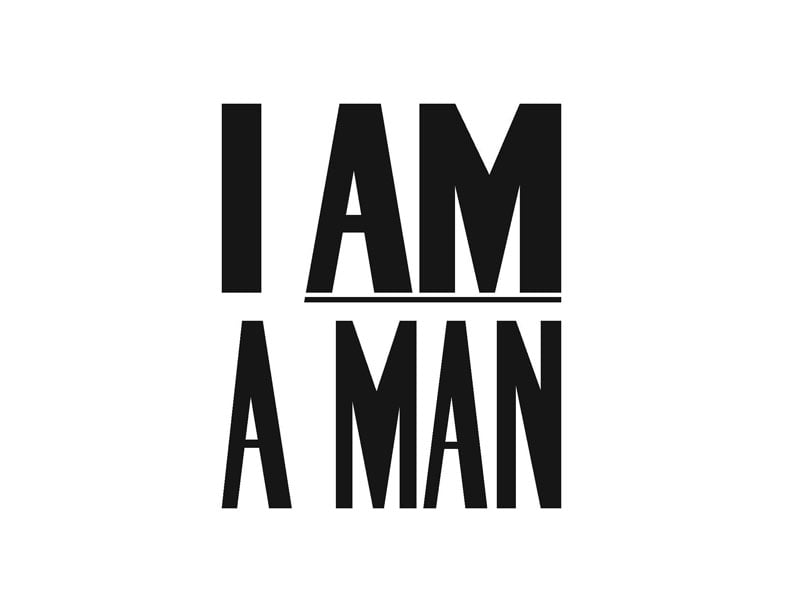
© » KADIST
Hank Willis Thomas
The image is borrowed from protests during Civil Rights where African Americans in the south would carry signs with the same message to assert their rights against segregation and racism. Historically, in countries such as the US and South Africa, the term “boy” was used as a pejorative and racist insult towards men of color, slaves in particular, signifying their alleged subservient status as being less than men. In response, Am I Not A Man And A Brother?

© » KADIST
Hank Willis Thomas
Bread and Roses takes its name from a phrase famously used on picket signs and immortalized by the poet James Oppenheim in 1911. “Bread for all, and Roses, too’—a slogan of the women in the West,” is Oppenheim’s opening line, alluding to the workers’ goal for wages and conditions that would allow them to do more than simply survive. Thomas’ painting includes several black, white, brown, yellow, and red raised fists—clenched and high in the air in the internationally recognized symbol of solidarity, resistance, and unity.

© » KADIST
Hank Willis Thomas
Drawing & Print (Drawing & Print)
Intentionally Left Blanc alludes to the technical process of its own (non)production; a procedure known as retro-reflective screen printing in which the image is only fully brought to life through its exposure to flash lighting. Using a found photograph depicting a passionate crowd of African Americans—their attitude suggesting the fervor of a civil-rights era audience— Intentionally Left Blanc reverts in its exposed, “positive” format to an image in which select faces are whitened out and erased, the exact inverse of the same view in its “negative” condition. This dialectic of light and dark re-emerges when we view the same faces again, only this time black and featureless, a scattering of disembodied heads amidst a sea of white.

© » KADIST
Hank Willis Thomas
Drawing & Print (Drawing & Print)
Thomas’ lenticular text-based works require viewers to shift positions as they view them in order to fully absorb their content. Meaning, therefore, changes depending on one’s perspective—and in the case of Thomas’ installation, only emerges when one knows that there is always something hidden, always more to one of his works than immediately meets the eye. This lenticular print with text shifts as you walk in front of it from its title, “Black Imitates White” to the inverse, “White Imitates Black”(and some other possibilities in between) emphasizing that there are always at least two perspectives to the same scenario, and thereby encouraging us as viewers to consider them all together rather than trying to identify with any one subjectivity.

© » KADIST
Hank Willis Thomas
Like many of his other sculptural works, the source of I am the Greatest is actually a historical photograph of an identical button pin from the 1960s. I am the Greatest presents the famous quote by Mohammad Ali to think about his important presence in the African American community. In dialogue with the painting I am a Man, also in the Kadist collection, this assertion that begins the same way takes the line from the protest poster several steps further.

© » KADIST
Thomas Kilpper
Drawing & Print (Drawing & Print)
These two images come from the series called “State of Control” which Kilpper made in the building formerly occupied by the Stasi in Berlin. As a symbol of the past there could be none more powerful than this. By carving into its floor, Kilpper laid bare its history by making images of its occupants and political figures associated with that period of history.

© » KADIST
Thomas Kilpper
Drawing & Print (Drawing & Print)
These two images come from the series called “State of Control” which Kilpper made in the building formerly occupied by the Stasi in Berlin. As a symbol of the past there could be none more powerful than this. By carving into its floor, Kilpper laid bare its history by making images of its occupants and political figures associated with that period of history.
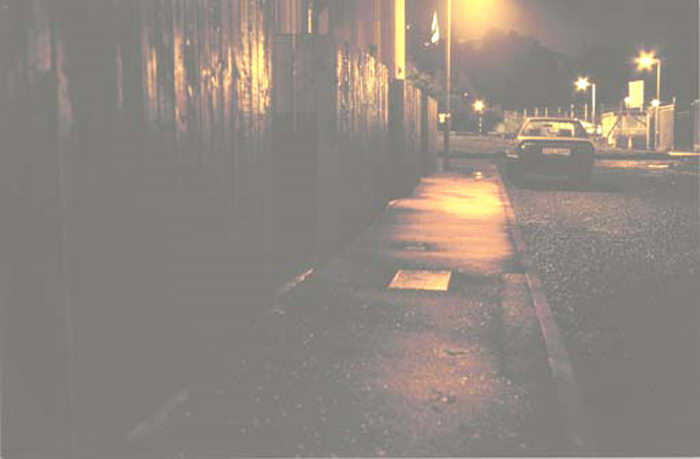
© » KADIST
Willie Doherty
“I focused on how the political and physical merged” analyzes Willie Doherty. Out of the Shadows II plunges us into a dark night lit by a few street lights in a deserted street where a car is parked in the Irish city of Derry. What is at stake is yet to be unearthed.

© » KADIST
Hana Miletic
Incompatibles (Unitas) is made from discarded samples of the yarns that are exported from Croatia and not actually available in the local market. The textile industry in former Yugoslavia has essentially closed down under pressure from Indian and Chinese industries and as a result of the botched privatization of once state-owned factories. There is only one factory remaining in Zagreb producing these yarns.

© » KADIST
Andrew Thomas Huang
Highly autobiographical, exquisitely made and compiling different aspects of the artist’s practice, Kiss of the Rabbit God is one of Andrew Thomas Huang’s most precise, relevant, and successful videos. This video work exemplifies a new, global wave of queering tradition, indigenous references and international pop/post-internet esthetics. In this short video, a Chinese-American restaurant worker falls in love with an 18th century Qing dynasty god of gay lovers who visits him at night and leads him on a journey of sexual awakening and self discovery.

© » KADIST
Aubrey Williams
Carib Carnival illustrates Aubrey Willams’s unique artistic language, combining Pre-Columbian iconography with abstraction. A series of abstracted shapes that resemble bones, masks and serpent-like images surrounded by fiery vapors and gases, illustrate the destruction of culture as one of the predominant themes of Williams’s work. He considered the Mayan and Aztec cultures to exemplify a number of present-day faults; according to Williams they developed technologies that would eventually lead to their own destruction.
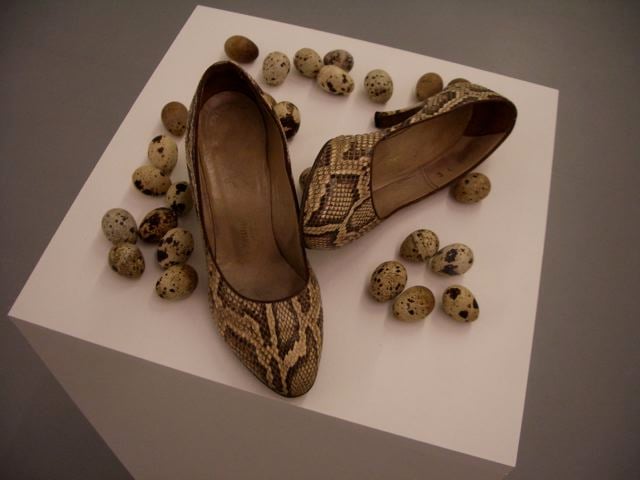
© » KADIST
Hans-Peter Feldmann
The types of objects Feldmann is interested in collecting into serial photographic grids or artist’s books are often also found in three dimensional installations. Verging on a form of fetichism, his shoe collections are a case in point and indeed, for some exhibitions, he even asked gallery employees for their shoes. Against authorship and the commodification of art, he never gives titles or dates to his works which have infinite edition possibilities.
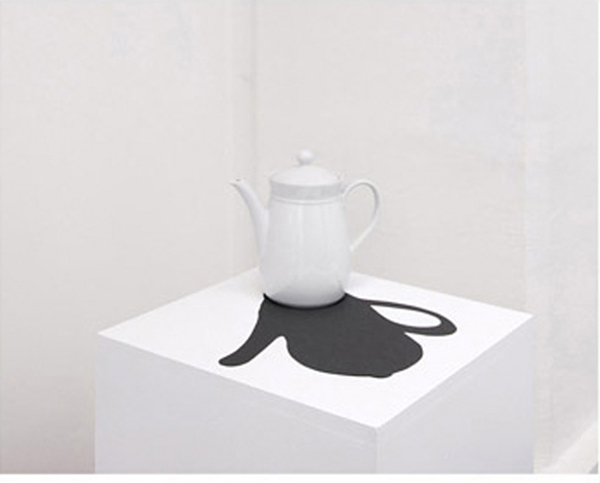
© » KADIST
Hans-Peter Feldmann
The types of objects Feldmann is interested in collecting into serial photographic grids or artist’s books are often also found in three dimensional installations. Against authorship and the commodification of art, he never gives titles or dates to his works which have infinite edition possibilities. This mise en scène of found kitchenware also exists with a rounder and flatter plain modern white porcelain teapot.
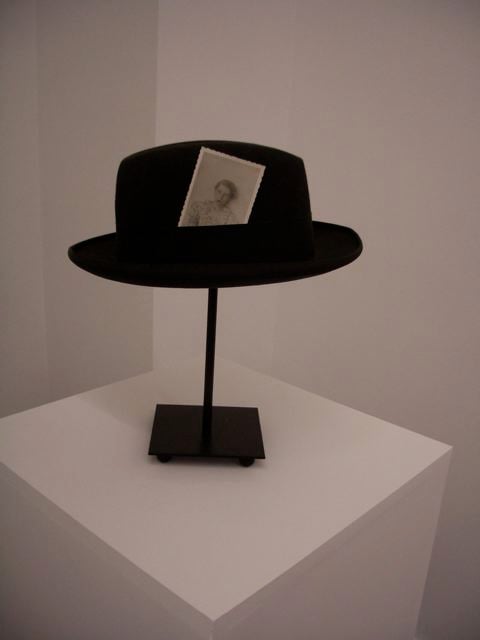
© » KADIST
Hans-Peter Feldmann
The types of objects Feldmann is interested in collecting into serial photographic grids or artist’s books are often also found in three dimensional installations. Hats and photographs are regularly part of his appropriations and arrangements. He famously made numerous trips to England in search of old photographs when he was an antique dealer, and then worked in a gift store with his wife when he left the art world in the 1980s.

© » KADIST
William E. Jones
In the early 20th century, the Hercules Engine Company was doing a brisk business producing customized, heavy-duty engines. Seventy years later, when the United States military started opting for Humvees and stock parts, the company began to fail, and it entirely ceased production in 1999. Hercules Engines, Abandoned, Canton, Ohio (2011) depicts the manufacturer’s former productive core, gone fallow.

© » KADIST
D’Angelo Lovell Williams
On January 7th, 2020, artist D’Angelo Lovell Williams was diagnosed with HIV. Only a handful of chosen family members knew up until the public announcement that coincided with the release of this body of work. According to the artist, “discovery” is key to this group of large photographs.

© » KADIST
William E. Jones
In Restaurant, Canton, Ohio (2011), a convenience store offers food, liquor, and Coca Cola to an empty street. A series of boarded-up storefronts marred by peeling paint conveys a sense of the pre- or post-apocalyptic—the hush just before or after a disaster. The reds, pinks, and oranges of the buildings give off warmth, but the absence of human activity makes the glow eerie and strange.

© » KADIST
William E. Jones
Killed is a video projection in which William E. Jones appropriated and edited, in a rapid sequence, a selection from the more than 68,000 censored or discarded films produced by the Farm Security Administration’s photographers between 1935 and 1943. Roy Emerson Stryker, the then director of the program, was in charge of what he called “killing” negatives by punching holes in them to render them unusable. Killed continues Jones’s use of discarded film footage seen in his video created from vintage 1970s and 1980s gay porn that was included in the 2008 Whitney Biennial.

© » KADIST
Christine Sun Kim and Thomas Mader
Indexes that either allow or inhibit the establishment of communication exist in both signed as well as spoken languages. Some differ radically depending on a variety of social, economic and geographical factors, while others are universally understood. Seemingly small and fleeting gestures can determine a sense of affiliation or a feeling of rejection.

© » KADIST
Will Rogan
Drawing & Print (Drawing & Print)
MUM , the acronym used to title a series of Rogan’s small interventions on found magazines, stands for “Magic Unity Might,” the name of a vintage trade magic publication. In the series, Rogan alters the magazine’s pages by erasing the image of the magicians doing their tricks, leaving only the background of their performances on view. These contexts range from the more overtly staged scenario in Silencer #16 —the erased magician is about to perform a trick on his assistant trapped on an odd, almost dada looking box—to the more “colloquial” Silencer #17 in which the absent magician’s silhouette appears in what seems to be a children’s hospital.

© » KADIST
Will Rogan
Will Rogan’s video Eraser (2014) shows a hearse parked in a clearing amidst leaf barren trees. The steely grey sky stands in stark contrast to the vehicle’s luminously pristine white finish and makes this already deathly object seem even more ghostly. The grass underneath is half-turned brown and further marks this as a lifeless landscape.

© » KADIST
William E. Jones
His series, The Golden State, harkens back to his early career and his photographic training. Using a still camera to compose the fifty images of the series, Jones turns his lens on the vernacular architecture of California’s southern region, looking at the iconic and idiosyncratic spaces that define a region. William E. Jones is a filmmaker, writer, and artist whose interests lie in the circulation of images—images that are broadcast, images that are hidden, and images that become imbedded in our collective consciousness.
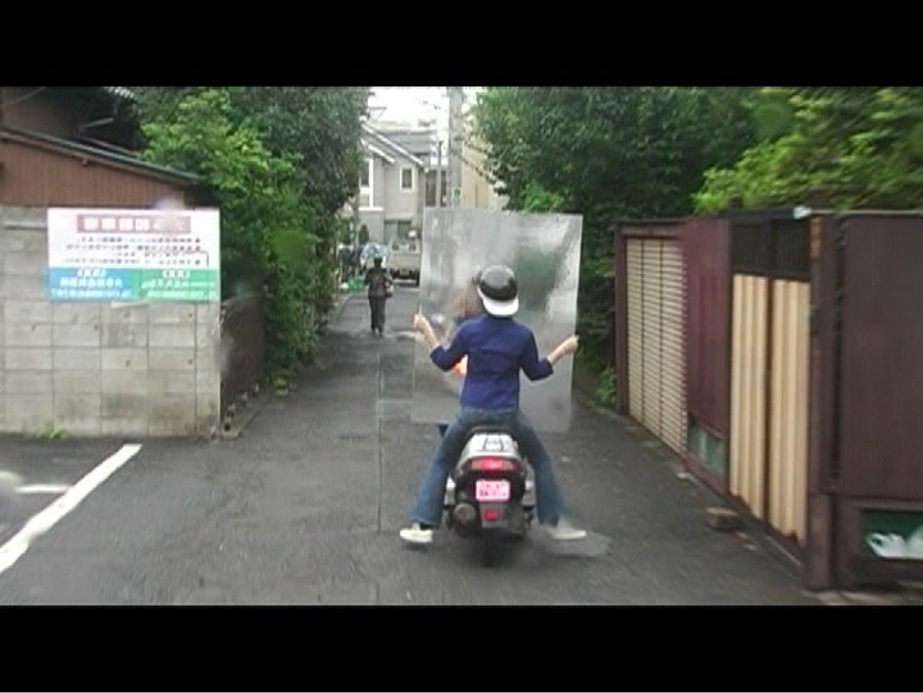
© » KADIST
Will Rogan
Shot in the streets of Tokyo, Collapse , is a meditation on the passing of time and on the complicated way in which we are smashed between the past and the future. The video follows a moped carrying a woman holding a very large mirror. The mirror is large enough that she can’t see what lies ahead, she can only see what has already come as reflections in the mirror.

© » KADIST
Paloma Contreras Lomas
Drawing & Print (Drawing & Print)
Paloma Contreras Lomas sometimes incorporates large scale drawing into her practice. For Contreras, drawing is a deeply personal and corporeal exercise that she relates to writing and narration. Her charcoal drawing Bugs Bunny Behind a Mesophile Bush features a gigantic hat providing shelter to the simultaneously identifiable and unidentifiable cartoon character hiding behind a wild bus.

© » KADIST
Paloma Contreras Lomas
Paloma Contreras Lomas has frequently used animals as metaphors in her work. This work’s title, Cimarrón , is the Spanish word for an untamed animal, the wild vegetation that grows in the open, or a runaway slave. Cimarrón is part of a larger series in which the artist turned scaled-up Mexican hats into meticulously hallucinatory landscapes.
Hank Willis Thomas
- location: New York, New York
- year born: 1976
- gender: male
- nationality: American
- home town: Plainfield, New Jersey
Will Rogan
- location: Albany, California
- year born: 1975
- gender: male
- nationality: American
Hans-Peter Feldmann
- location: Düsseldorf, Germany
- year born: 1941
- gender: male
- nationality: German
- home town: Dusseldorf, Germany
Thomas Kilpper
- location: Stuttgart, Deutschland
- year born: 1956
- gender: male
- nationality: German
Paloma Contreras Lomas
A writer and an artist, Paloma Contreras Lomas has developed a practice in which literature and fiction play a major role, allowing her to address a series of topics regarding race and class that are rarely broached by a traditional Mexican society...
Hana Miletic
Hana Miletic is a Croatian artist living in Brussels with a background in documentary and street photography...
Aubrey Williams
Aubrey Williams was one of the founding members of the Caribbean Artists Movement, formed in the 1960s in the United Kingdom, after settling there in the early 1950s...
Willie Doherty
- location: Derrybrien, Éire
- year born: 1959
- gender: male
- nationality: Irish
Andrew Thomas Huang
Andrew Thomas Huang is one of the most original upcoming film makers working at the intersection of tradition, spirituality, non-Western imaginary, queerness, and digital fantasies and technical possibilities...
Christine Sun Kim and Thomas Mader
Christine Sun Kim and Thomas Mader have been collaborating for the last 5 years, covering communication in a variety of formats such as recording an overnight shipment from Berlin to New York ( Recording Contract , 2013), compiling 24 hours of invited contributors’ studio time ( Busy Day , 2014), and using the arm game, a combination of body and face, in order to describe a series awkward situations ( Classified Digits , 2016)....
-
1970-1979
Aubrey Williams
1972Carib Carnival illustrates Aubrey Willams’s unique artistic language, combining Pre-Columbian iconography with abstraction...
-
1990-1999
-
2000-2009
William E. Jones
2000His series, The Golden State, harkens back to his early career and his photographic training...
Will Rogan
2007Shot in the streets of Tokyo, Collapse , is a meditation on the passing of time and on the complicated way in which we are smashed between the past and the future...
Thomas Kilpper
Drawing & Print
2009(Drawing & Print) These two images come from the series called “State of Control” which Kilpper made in the building formerly occupied by the Stasi in Berlin...
Thomas Kilpper
Drawing & Print
2009(Drawing & Print) These two images come from the series called “State of Control” which Kilpper made in the building formerly occupied by the Stasi in Berlin...
-
2010-2019
Will Rogan
Drawing & Print
2010(Drawing & Print) MUM , the acronym used to title a series of Rogan’s small interventions on found magazines, stands for “Magic Unity Might,” the name of a vintage trade magic publication...
William E. Jones
2011In the early 20th century, the Hercules Engine Company was doing a brisk business producing customized, heavy-duty engines...
William E. Jones
2011In Restaurant, Canton, Ohio (2011), a convenience store offers food, liquor, and Coca Cola to an empty street...
Hank Willis Thomas
2012Bread and Roses takes its name from a phrase famously used on picket signs and immortalized by the poet James Oppenheim in 1911...
Hank Willis Thomas
Drawing & Print
2012(Drawing & Print) Intentionally Left Blanc alludes to the technical process of its own (non)production; a procedure known as retro-reflective screen printing in which the image is only fully brought to life through its exposure to flash lighting...
Hank Willis Thomas
Drawing & Print
2012(Drawing & Print) Thomas’ lenticular text-based works require viewers to shift positions as they view them in order to fully absorb their content...
Hank Willis Thomas
2012Like many of his other sculptural works, the source of I am the Greatest is actually a historical photograph of an identical button pin from the 1960s...
Hank Willis Thomas
2013The image is borrowed from protests during Civil Rights where African Americans in the south would carry signs with the same message to assert their rights against segregation and racism...
Hank Willis Thomas
2014South Africa Righteous Space by Hank Willis Thomas is concerned with history and identity, with the way race and ‘blackness’ has not only been informed but deliberately shaped and constructed by various forces – first through colonialism and slavery, and more recently through mass media and advertising – and reminds us of the financial and economic stakes that have always been involved in representations of race....
Hank Willis Thomas
Drawing & Print
2014(Drawing & Print) Shot in black and white and printed on a glittery carborundum surface, Black Hands, White Cotton both confronts and abstracts the subject of its title...
Will Rogan
2014Will Rogan’s video Eraser (2014) shows a hearse parked in a clearing amidst leaf barren trees...
Christine Sun Kim and Thomas Mader
2016Indexes that either allow or inhibit the establishment of communication exist in both signed as well as spoken languages...
D’Angelo Lovell Williams
2018On January 7th, 2020, artist D’Angelo Lovell Williams was diagnosed with HIV...
Hana Miletic
2019Incompatibles (Unitas) is made from discarded samples of the yarns that are exported from Croatia and not actually available in the local market...
Andrew Thomas Huang
2019Highly autobiographical, exquisitely made and compiling different aspects of the artist’s practice, Kiss of the Rabbit God is one of Andrew Thomas Huang’s most precise, relevant, and successful videos...
-
2020-2029
Paloma Contreras Lomas
Drawing & Print
2020(Drawing & Print) Paloma Contreras Lomas sometimes incorporates large scale drawing into her practice...
Paloma Contreras Lomas
2020Paloma Contreras Lomas has frequently used animals as metaphors in her work...
